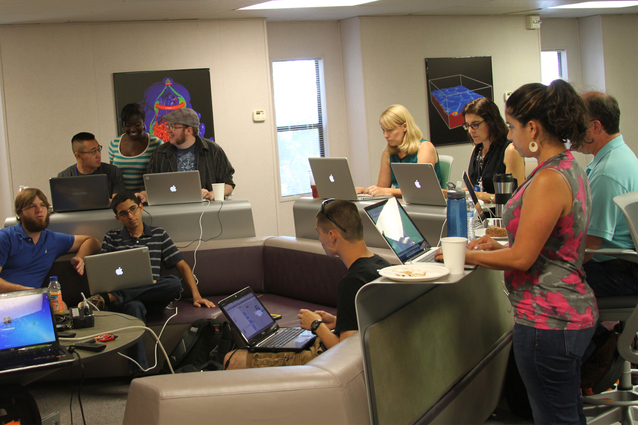Hackathon generates ideas, strengthens ties, promotes fun
 (Download Image)
Computation's hackathons are 24-hour events that encourage collaborative programming and creative problem solving. At the most recent session, 58 employees and students worked on 30 teams to complete Computation-related projects of their choice.
(Download Image)
Computation's hackathons are 24-hour events that encourage collaborative programming and creative problem solving. At the most recent session, 58 employees and students worked on 30 teams to complete Computation-related projects of their choice.
A record 58 employees and students took part in Computation's summer hackathon, held from July 31 to Aug. 1 in theHigh-Performance Computing Innovation Center. The event was hosted byLivermore Computing.
During hackathons, participants -- working individually or in teams -- strive to complete a Computation-related project of their choice in 24 hours or less.
The measure of success, according to event organizer Greg Lee, is that people had a good time, met new people and felt that they had made progress on their projects.
"Some past hackathon events have included competition between project teams, but we realized it wasn't essential," he said. "People do present their project results at the end of the event, though." Lee noted that a project to enhance LITE, the Lab's timekeeping system, seemed particularly popular with this hackathon crowd.
Two years in, the volunteer-organized events are hitting their stride, according to Lee. "We have developed a good infrastructure and gained enough experience from previous events that we can run a hackathon with minimal overhead on the hackathon committee," he said.
Nearly half of the participants at the most recent hackathon were from the Institute for Scientific Computing Research'sscholar program. For these students, the event was a great opportunity to apply the skills they have been learning over the summer.
For instance,Cyber Defendersinterns Devon Ellis and Henry Williams assembled, with the help of Williams' homemade 3D printer, a Raspberry Pi-powered Wi-Fi tool. Raspberry Pi is a learning tool used regularly in the cybersecurity internship program.
Ellis explained, "Our project involves creating a Wi-Fi jammer, which can selectively kill networks around us. The reason behind it is to do network penetration testing for the Lab, but it has other useful applications, too, like helping to teach younger students about wireless protocols."
For employees, the event offered a chance to break out of daily routine and try something different, automate a tedious task, complete a project from the last event, or learn something new.
For instance, Walt Nissen joined the hackathon to learn a new programming language. "I've been working on the same project for 15 years, and while there are certainly daily challenges, the technologies I work with aren't that diverse," he said. "The hackathon gives me a chance to try out things I don't know so much about, and if my efforts fail, I've only lost a day. It's great."
But the best part of the codefests, many said, is the people. Veteran participant Gary Laguna noted: "Summer is our favorite time to have hackathons because the students participate. They continually impress us with their ideas, and they add a lot of value to our teams. In general, these events are great because we get to interact with people we don't normally and strengthen professional ties."
Not only are the events popular with employees and students, they also bring real value to the programs; a number of projects from past hackathons have been incorporated into production code. Projects are posted on a Confluence wiki to help facilitate idea transfer.
For many hackathon participants, once they've attended one, they're hooked. Francesca DeMello observed, "One of the fun parts is deciding what project to do ."
The next hackathon event is tentatively scheduled for the fall.
Contact
Rose A Hansen[email protected]
9254235575
Related Links
Software Developers Get Their Hack On'ShipIt Day' comes to the Laboratory
Tags
HPC, Simulation, and Data ScienceComputing
Featured Articles







